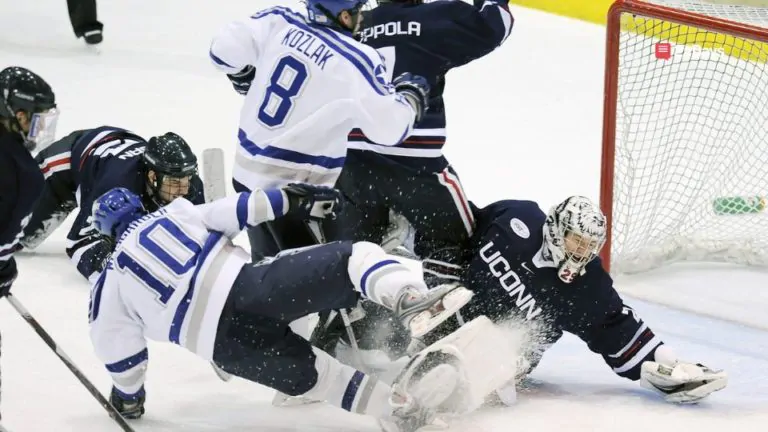This past month the NCAA approved rule changes on a number of issues for the 2018-19 college baseball season. The changes address issues such as player safety, the pace of play, clarification of ambiguous rules, and the use of video replay. From an outsider's perspective, the rule changes seem to be an attempt to bring college baseball in closer alignment with the way in which major league baseball is played. But some of the rules might be considered overreaching, removing elements of the game that is at the core of what baseball is about.
Player Safety
A primary goal of the NCAA is to maximize the safety of its student-athletes, especially when doing so does nothing to undermine the sport's value. One of the new rules aims to do this by address catcher safety. The rule awards a strike anytime that the batter hits the catcher with their backswing.
Other new rules involving safety include awarding pitchers a strike if the batter intentionally leans to get hit by a pitch. In addition to prohibiting all uniformed team personnel from standing or sitting in the dugout extension area during play.
Video Replay
The use of video replay will see some changes in the coming year as well. In the 2018-19 season, coaches will be able to challenge two play a game from a list of 12 reviewable plays. Of the 12 reviewable plays, six can be challenged at any time by the crew chief, and the crew chief can challenge the other six only in the last two innings of regulation and extra innings.
Six plays that are currently reviewable:
- If a batted ball is fair or foul when the ball has first touched the ground or a fielder beyond the initial position of the first and third baseman.
- If a batted ball is a ground-rule double or a home run.
- If any catch or no catch call in the outfield or foul territory.
- If a call of “no catch” can be changed to “catch” within the infield if the catch results in the third out with any runners or at any time with a batter-runner only.
- If spectator interference occurred.
- Scoring plays at home plate, including collisions or time plays.
Six additional plays that are being recommended to be reviewable:
- Force and tag play at any base.
- Plays involving runners passing a preceding runner, scoring prior to the third out, and whether a runner touched a base.
- Plays involving hit by pitch.
- If a runner failed to retouch his base after a fair or foul ball is caught.
- The umpire's placement of a batter-runner or runners following a boundary call.
- If interference occurred in an attempt to break up a double play.
Pace of Play
One major issue that the NCAA hopes to address with these rule changes is the pace of play, something that seems to impact all levels of baseball. The NCAA approved many changes in hopes of speeding up the average time it takes to complete games.
One of these rules is increased restrictions on the number of defensive meeting players and coaches can have. For the coming season defensive conferences now will be limited to six per regulation contest, of those six a maximum of three can include a coach. This is a change that attempts to mimic what Major League Baseball has done in recent years and will force managers to be more strategic with how they use their meetings.

A somewhat counter-intuitive rule change aimed at the pace of play was the decision to increase the time between innings to 120-seconds for all games, from 90 seconds (for untelevised games) and 108 seconds for televised games. This rule is intended to improve consistency between untelevised games and televised games. Additionally, it mandates that the clock start immediately after the last out is made and not when all the players get off the field, to improve both consistency and pace of play.
The NCAA next season will adopt the same no-pitch intentional walk rule that Major League baseball adopted in 2017. That is if a coach wishes to walk a batter intentionally he can tell the ump and the player immediately takes first base instead of having the pitcher throw four balls. While this would speed up play, there are many examples of intentional walks that have gone wrong, with pitchers throwing errant balls or runners stealing bases (https://www.youtube.com/watch?v=IJBMm70kRgo). So, while the speed of play might increase by a small amount, it comes at the cost of eliminating a tool that the offensive team could use.
A proposed rule change that was ultimately not approved was two 20-second play clocks. Members of the NCAA panel felt that the costs and installation of the clocks would be too much to bear for the limited improvement in the quality of play that they would provide. But they did not mention the potentially negative effects that a play clock might have on the game.
While the NCAA aims at reducing the time it takes to play games the effect of these changes must be evaluated. After all, baseball at its nature is a methodical game where small adjustments in strategy can have a significant impact on a game. If rules and timers continue to be added the nuances that are unique to baseball may unintentionally take a back seat in favor of the speed at which the games are played.
Head Baseball Coach at the University of Rochester Joe Reina sees some of these changes as a slippery slope saying, “I don't know if time has a place in baseball.”. By trying to improve pace play the NCAA may be forgetting what baseball is all about.
http://www.ncaa.org/sites/default/files/2018MBA_Final_Approved_Changes_20180824.pdf
* Originally published on October 22, 2018, by Brendan O'Shea







